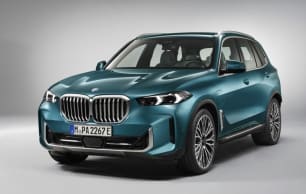Chery says the Omoda E5 will accelerate from 0-100km/h in 7.6 seconds which is pretty rapid and there’s plenty of thrust from a standing start and for dodgem car-style city manoeuvring. There’s also ample oomph for safe highway cruising and overtaking.
There are three powertrain modes - Eco / Normal / Sport - with the latter adding some extra urgency but there’s not a dramatic difference between the three.
The column-mounted gear selector is in the style of a Mercedes lever rather than a rotary controller and it initially takes conscious effort to avoid flicking it like an oversize indicator stalk.
Once settled in, though, it becomes second-nature and its location frees up extra space for storage in the console between the front seats.
Chery says it spent eight months on local testing and development of the suspension tune, powertrain integration and safety assistance systems and we believe the car could be better in aspects of all three.
The Omoda 5 rides on a platform designed to accommodate combustion and electric propulsion from day one and the front-wheel-drive E5 is suspended by struts at the front and multi-links at the rear.
It takes a lot to manage close to 1.8 tonnes of mass in a relatively small car. Walking the tightrope between body control and ride comfort is tricky with a beefy battery onboard and the E5’s around town ride is best described as jittery, upset by even moderately rough surfaces, although things improve as road speed rises.
The 18-inch rims are shod with 215/55 Kumho PS71 EV rubber and despite its relatively stubby sidewall we’ve driven this tyre on other cars without issue, so it’s likely not the culprit.
Steering weight can be adjusted but road feel is modest and quick cornering isn’t the E5’s forte. But it’s not that kind of car. Urban duties rather than slicing through a favourite set of corners will be its more likely primary purpose, and for that, the steering’s fine.
Then, no matter which drive mode you’ve selected, or the level of regen braking, it’s hard to be 100 per cent smooth with accelerator and brake inputs. They can be sharp on application and lift-off.
And when it comes to assist systems, lane-keeping intervention when using cruise control is abrupt and annoying. The centring function can be switched off but, ideally, you shouldn’t have to.
And likewise, the driver attention warning is intrusive. To the point where it fired an alert at times where I was looking directly at the road ahead. Again, it can be turned off (which is what I’d do 100 per cent of the time) but the calibration could be better.
Physical braking is by vented discs at the front and solid rotors at the rear and three levels of regen braking are available. Snag is you have to work through multiple screen options to get to the point where you can adjust it. Wheel-mounted paddles would be far more effective but the bean counters must have won the arm wrestle with engineering.
Once you apply the most aggressive regen level, even it is relatively low-key, so no i-Pedal-style single-pedal driving here.
In terms of miscellaneous observations, strategic inclusion of acoustic glass on the EX grade seems worthwhile as the mild highway wind noise we noticed on the BX wasn’t apparent in the top-spec model.
And the lack of a conventional dial for audio volume control is a miss. Far safer to quickly adjust a dial than sliders or buttons (even on the steering wheel).
Interesting to note Euro NCAP is lining up to make inclusion of physical controls for things like audio volume, turn signals, hazard lights, wipers and the horn mandatory for a maximum five-star safety assessment from 2026 onwards.

